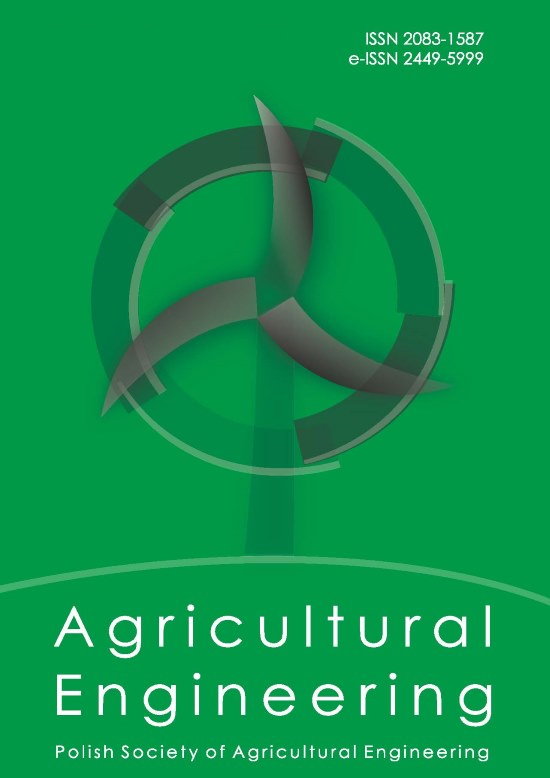Production Capacity and Workstations Load in the Animal Feed Production Process
DOI:
https://doi.org/10.1515/agriceng-2016-0009Keywords:
workstation, production capacity, working load, technical performanceAbstract
Production capacity is the amount of production with the determined assortment structure possible to achieve by a particular production unit in a determined time at the optimal use of production factors and at maintaining the products quality corresponding to standards. The objective of the paper was to determine the production power and output of particular workstations which constitute an assembly line of dry animal feed. The scope of research covered an assembly line in the establishment which produces dry feed for pet animals. Based on information and documentation obtained from the company manager and on the work schedule determined for particular workstations, the operation time of a machine, human work time (operation of a machine) and operation time of the entire station with its working surface was determined. Research showed that workstations which constituted the assembly line of dry animal feed were loaded within 76 to 86%. The lowest loading was reported in the mill and LP02 assembly line and it was respectively 76 and 78%. Whereas loading of the remaining devices was comparable and was at the level within 84 to 86%.Downloads
Published
2016-07-24
Issue
Section
Articles
How to Cite
Production Capacity and Workstations Load in the Animal Feed Production Process. (2016). Agricultural Engineering , 20(1), 91–100. https://doi.org/10.1515/agriceng-2016-0009
Most read articles by the same author(s)
- Jan Radosław Kamiński, Maciej Kuboń, Irina Dmitrevna Ivanova, Andreev Viktorovich Sergutenko, The Analysis of the State Space of Management Process in the Industry Applying Expert Systems , Agricultural Engineering : Vol. 21 No. 2 (2017)
- Maciej Sporysz, Maria Szczuka, Sylwester Tabor, Krzysztof Molenda, Maciej Kuboń, The Use of Cluster Analysis in Assessing the Sustainability of Organic Farms. Part I. Methodical Considerations , Agricultural Engineering : Vol. 23 No. 4 (2019)
- Vadym Bredykhin, Taras Shchur, Liliia Kis-Korkishchenko, Serhii Denisenko, Serhii Ivashchenko, Andrzej Marczuk, Oleg Dzhidzhora, Maciej Kubon, Determination of Ways of Improving the Process of Separation of Seed Materials on the Working Surface of the Pneumatic Sorting Table , Agricultural Engineering : Vol. 28 (2024)
- Aleksandr Viktorovich Klochkov, Vladimir Vladimirovich Gusarov, Maciej Kuboń, Jan Radosław Kamiński, Threshing and Grain Separating Mechanism with Differentiate Concave for Intensification of Threshing and Grain Separation , Agricultural Engineering : Vol. 21 No. 3 (2017)
- Dariusz Kwaśniewski, Tadeusz Juliszewski, Józef Walczyk, Paweł Tylek, Florian Adamczyk, Jan Szczepaniak, Fuel Consumption and Effectiveness of Elimination of Energy-crop Willow Plantation , Agricultural Engineering : Vol. 21 No. 4 (2017)
- Dariusz Kwaśniewski, Cengiz Akdeniz, Faruk Durmaz, Fırat Kömekçi, Economic Analysis of the Photovoltaic Installation Use Possibilities in Farms , Agricultural Engineering : Vol. 24 No. 4 (2020)
- Filip Jasiczek, Dariusz Kwaśniewski, Analysis of Production Technology of Wood Briquettes, Including Costs and Distribution , Agricultural Engineering : Vol. 24 No. 1 (2020)
- Dariusz Kwaśniewski, Logistic and Economical Preconditions for Production of Pellets From Sawdust , Agricultural Engineering : Vol. 23 No. 2 (2019)
- Katarzyna Szwedziak, Petr Dolezal, Sylwester Tabor, Jacek Ogrodniczek, Electrotechnical Tools and Computer Image Analysis in Assessing the Quality of Maize Grain During Storage , Agricultural Engineering : Vol. 27 (2023)
- Dariusz Kwaśniewski, Tadeusz Juliszewski, Józef Walczyk, Paweł Tylek, Florian Adamczyk, Jan Szczepaniak, Work Inputs and Costs of Eradication of Energy Willow Plantation , Agricultural Engineering : Vol. 20 No. 4 (2016)

